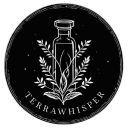
By Leen Randell
Updated: Oct 21, 2024
What to know about Hyptis suaveolens before using it medicinally

Hyptis suaveolens, commonly known as bush violet, is an herb that has been traditionally used to treat various health conditions, including digestive issues, respiratory problems, and skin conditions such as eczema and acne.
The main health benefits associated with Hyptis suaveolens include its anti-inflammatory, antimicrobial, and antioxidant properties, which can help to reduce inflammation, combat infections, and protect against cell damage. The herb's therapeutic properties include its ability to relax the muscles, reduce anxiety and stress, and improve sleep quality. Hyptis suaveolens contains a range of bioactive compounds, including flavonoids, phenolic acids, and essential oils, which are responsible for its medicinal properties.
In traditional herbal medicine, Hyptis suaveolens is often prepared as a tea, which can be consumed to harness its health benefits and alleviate symptoms of various health conditions.
The following article explains in detail what are the medicinal uses of Hyptis suaveolens, its health benefits, therapeutic properties, bioactive compounds, used parts, and herbal preparation. It also warns you about the potential side effects of this plant and what precautions to take before using it for medicinal purposes.
ARTICLE SUMMARY: The table below summarizes the most crucial information about Hyptis suaveolens provided in the article below, which is useful if you are in a hurry and don't have time to dig deep into the very detailed content that follows.
| Medicinal Aspect | Summary |
|---|---|
| Uses | Diarrhea, Fever, Insect bites, Skin infections, Asthma, Rheumatism, Anxiety, Eczema, Digestive issues, Respiratory issues |
| Benefits | Reduces inflammation, Kills bacteria, Cures fever, Relieves pain, Fights infections, Treats allergies, Soothes digestion, Fights cancer, Lowers blood, Eases anxiety |
| Properties | Antimicrobial, Antioxidant, Anti-inflammatory, Antiseptic, Antifungal, Analgesic, Antipyretic, Expectorant |
| Constituents | Phenolic acids, Saponins, Flavonoids, Terpenoids, Coumarins, Tannins, Rosmarinic acid, Quercetin, Glycosides, Kaempferol |
| Parts | Leaves, Flowers, Stems, Roots |
| Preparations | Tincture, Salve, Essential oil, Tea, Decoction, Poultice |
| Side Effects | Experiencing allergic reactions, Developing photosensitivity, Inducing gastrointestinal issues, Causing cardiac arrhythmias, Triggering asthma attacks, Producing nausea, Experiencing diarrhea, Developing skin irritation, Inducing vomiting, Experiencing abdominal pain |
| Precaution | Consult a healthcare professional, Start with low doses, Avoid during pregnancy and breastfeeding, Monitor blood pressure, Be aware of interactions with medications, Use under proper identification, Avoid contact with skin and eyes, Use only fresh or dried material, Be cautious in children and elderly, Report any adverse reactions |
BONUS CHEATSHEET: The cheatsheet below illustrates the most important medicinal aspects of Hyptis suaveolens. Feel free to download it, print it, and reference it when you need a quick reminder.
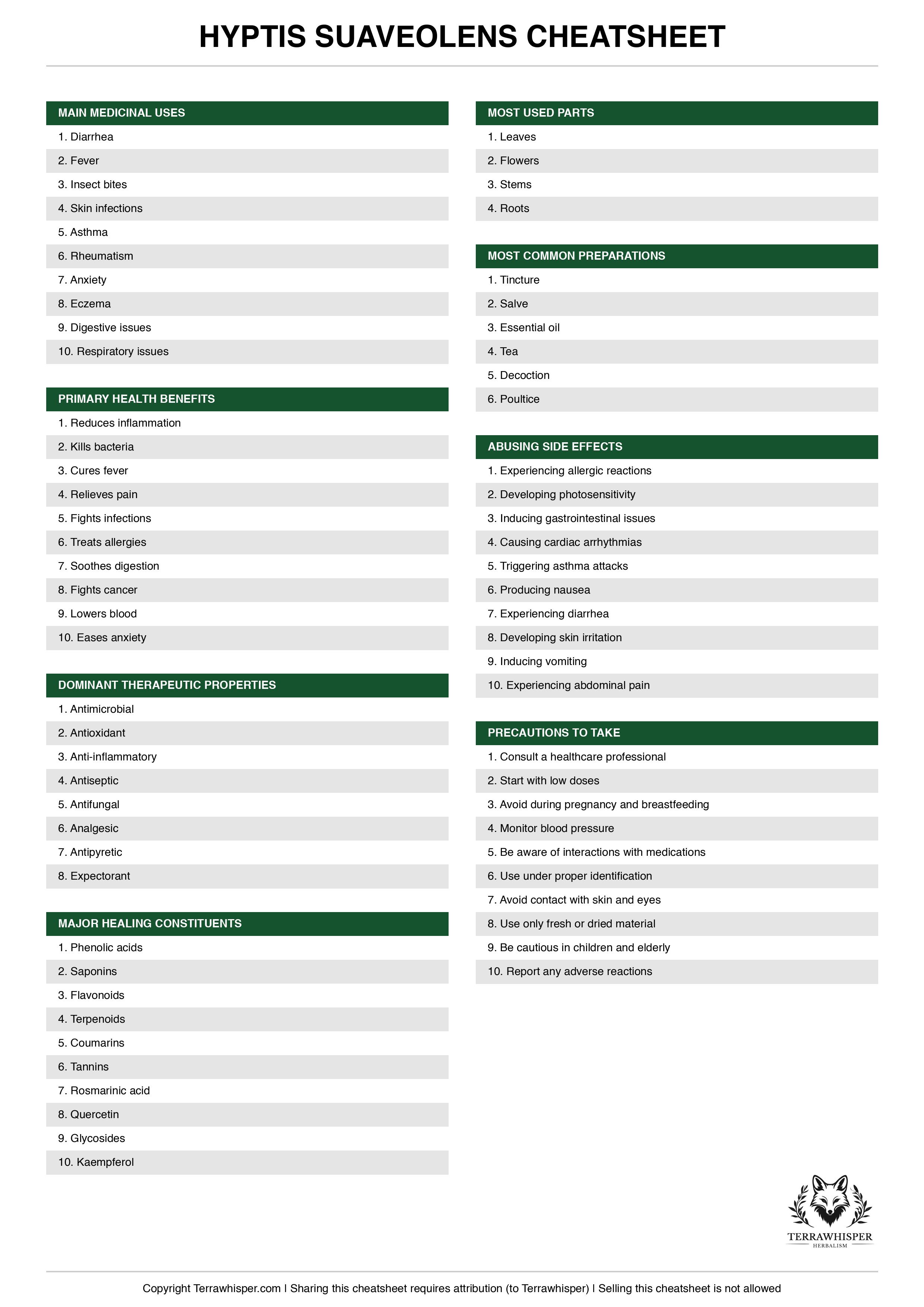
- What are the main medicinal uses of Hyptis suaveolens?
- Modern Western Medicine
- Traditional Chinese Medicine
- Ayurvedic Medicine
- Unani Medicine
- Homeopathic Medicine
- What are the primary health benefits of Hyptis suaveolens?
- Circulatory System
- Digestive System
- Endocrine System
- Integumentary System
- Lymphatic System
- Musculoskeletal System
- Nervous System
- Reproductive System
- Respiratory System
- Urinary System
- What are the dominant therapeutic properties of Hyptis suaveolens?
- What are the major healing constituents of Hyptis suaveolens?
- What are the most used parts of Hyptis suaveolens in medicine?
- What are the most common medicinal preparations of Hyptis suaveolens?
- What are the possible side effects of Hyptis suaveolens if used improperly?
- What are the precautions to take before using Hyptis suaveolens medicinally?
- Related herbs to Hyptis suaveolens?
What are the main medicinal uses of Hyptis suaveolens?
The main medicinal uses of Hyptis suaveolens are in the relief of fever, achieved through the antipyretic activity of its essential oil, which contains limonene and β-pinene.
This plant also has antispasmodic properties, making it effective in treating digestive issues, including dyspepsia, which is caused by the inhibition of gastric contractions by its sesquiterpene compounds. Additionally, the essential oil of Hyptis suaveolens has been shown to have anti-inflammatory and antimicrobial properties, useful in treating diarrhea, respiratory issues, and skin infections. Furthermore, its antiseptic and anti-inflammatory properties make it effective in treating insect bites and wound healing, while its flavonoids and phenolic compounds contribute to its anxiolytic effects, making it useful in treating anxiety.
The plant's essential oil also contains expectorant compounds, such as terpinen-4-ol, which makes it effective in treating cough.
The following illustration give a summary of the main medicinal uses of Hyptis suaveolens.
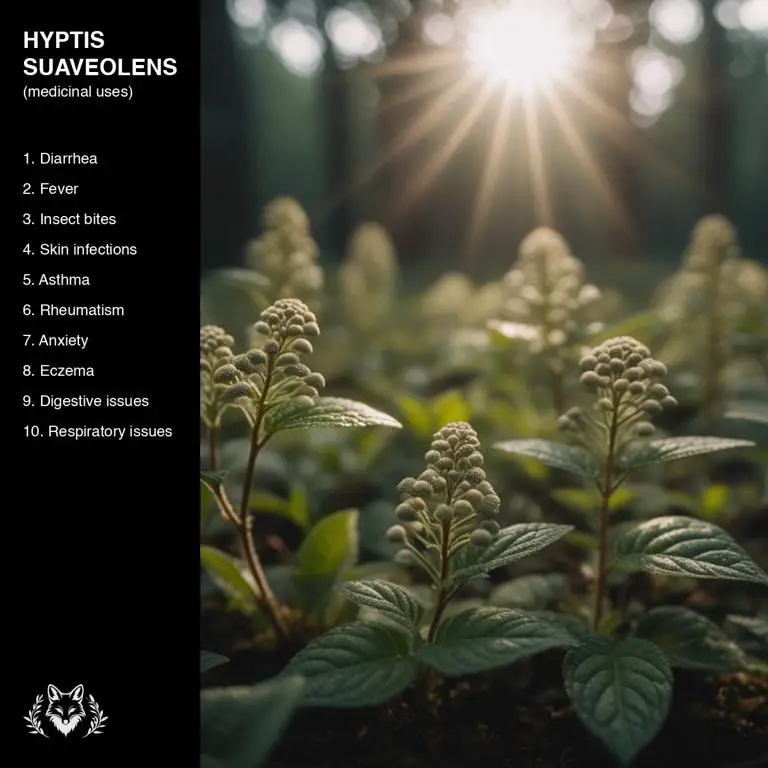
The list below provide more details on why Hyptis suaveolens is used to alleviate the health conditions mentioned in the illustration above.
- Diarrhea: This plant is used to treat diarrhea due to its antispasmodic properties, which help to relax the intestinal muscles and reduce inflammation, thereby alleviating the symptoms of diarrhea.
- Fever: The plant's essential oils have antipyretic properties, which help to reduce fever by acting on the body's thermoregulatory centers and increasing sweat production to cool the body down.
- Insect Bites: The plant's essential oils have anti-inflammatory and antiseptic properties, which help to reduce swelling, pain, and infection at the site of the insect bite, promoting faster healing and reducing the risk of further complications.
- Skin Infections: The plant's essential oils have antimicrobial properties, which help to combat bacterial, fungal, and viral infections of the skin, preventing the spread of the infection and promoting faster healing.
- Asthma: The plant's essential oils have bronchodilatory properties, which help to relax the muscles of the airways and increase airflow, making it easier to breathe and relieving the symptoms of asthma.
- Rheumatism: The plant's essential oils have anti-inflammatory and analgesic properties, which help to reduce pain and inflammation in the joints and muscles, alleviating the symptoms of rheumatism and promoting faster recovery.
- Anxiety: The plant's essential oils have anxiolytic and sedative properties, which help to calm the nervous system, reduce anxiety and stress, and promote relaxation and sleep.
- Eczema: The plant's essential oils have anti-inflammatory and antiseptic properties, which help to reduce redness, itching, and inflammation of the skin, promoting faster healing and reducing the risk of further complications.
- Digestive Issues: The plant's essential oils have antispasmodic and anti-inflammatory properties, which help to relax the intestinal muscles, reduce inflammation, and alleviate the symptoms of digestive issues such as bloating, cramps, and diarrhea.
- Respiratory Issues: The plant's essential oils have expectorant and bronchodilatory properties, which help to loosen and clear mucus from the airways, increase airflow, and relieve the symptoms of respiratory issues such as coughs, colds, and bronchitis.
The table that follows gives an overview of what are the most common health conditions that are treated with Hyptis suaveolens, in each of the major medicinal systems.
| Medicinal System | Conditions Treated |
|---|---|
| Modern Western Medicine | Insect Bites, Fever, Diarrhea, Skin Irritation, Rheumatism, Migraines, Wounds, Skin Infections, Fungal Infections, Respiratory Issues, Dyspepsia, Nausea, Anxiety, Digestive Issues, Inflammation, Respiratory Infections, Hypertension, Headache, Eczema, Sore Throat |
| Traditional Chinese Medicine | Insect Bites, Fever, Diarrhea, Skin Infections, Anxiety, Digestive Issues, Wounds, Rheumatism, Cough, Dyspepsia, Asthma, Skin Irritation, Headache, Gastroenteritis, Eczema, Menstrual Cramps, Respiratory Issues, Respiratory Infections, Muscle Pain, Colic |
| Ayurvedic Medicine | Diarrhea, Fever, Skin Infections, Insect Bites, Asthma, Anxiety, Respiratory Issues, Rheumatism, Eczema, Gastroenteritis, Digestive Issues, Fungal Infections, Wounds, Cough, Malaria, Headache, Migraine, Vomiting, Stomachache, Inflammation |
| Unani Medicine | Diarrhea, Fever, Asthma, Rheumatism, Skin Infections, Cough, Insect Bites, Eczema, Headache, Dyspepsia, Anxiety, Vomiting, Inflammation, Digestive Issues, Flatulence, Gastroenteritis, Nausea, Wounds, Respiratory Issues, Hiccups |
| Homeopathic Medicine | Insect Bites, Fever, Diarrhea, Anxiety, Eczema, Asthma, Fungal Infections, Skin Irritation, Skin Infections, Rheumatism, Respiratory Issues, Skin Inflammation, Migraines, Digestive Issues, Headache, Indigestion, Nausea, Dyspepsia, Menstrual Cramps, Cough |
Modern Western Medicine
In modern western medicine, Hyptis suaveolens is used to treat insect bites by reducing inflammation and itching, fever through its antipyretic properties, diarrhea with its anti-diarrheal compounds, skin irritation due to its antihistamine and anti-inflammatory effects.
Additionally, it is used to alleviate rheumatism by reducing pain and swelling, migraines through its analgesic and anti-migraine properties, and wounds by promoting healing and preventing infection. Furthermore, Hyptis suaveolens is effective in treating skin infections, fungal infections, respiratory issues such as bronchitis and asthma, and dyspepsia with its carminative and anti-spasmodic properties. It is also used to alleviate nausea, anxiety, digestive issues such as irritable bowel syndrome, and inflammation in the body.
The plant's antiseptic and antimicrobial properties make it useful in treating wounds, skin infections, and respiratory infections like pneumonia and sore throat, as well as hypertension, headache, eczema, and other conditions.
Traditional Chinese Medicine
In traditional chinese medicine, Hyptis suaveolens is used to treat a variety of health conditions, including insect bites which it is believed to alleviate through its anti-inflammatory properties, fever which is reduced by its ability to regulate body temperature, and diarrhea which is treated by its antispasmodic effect on the digestive system.
The plant is also used to combat skin infections, which it does by preventing the growth of pathogens, as well as anxiety, which is calmed by its sedative properties. Additionally, it is employed to address digestive issues such as dyspepsia, which it treats by improving digestion, and respiratory issues like cough and asthma, which are alleviated by its expectorant properties. Furthermore, it is used to treat skin conditions like eczema and skin irritation, as well as wounds, which it heals through its antimicrobial and antiseptic properties.
Other conditions that are treated with Hyptis suaveolens include rheumatism, which is relieved by its anti-inflammatory properties, respiratory infections, which it prevents through its immunomodulatory effect, menstrual cramps, which are alleviated by its uterotonic properties, and muscle pain, which is relieved by its analgesic effect, and colic, which is treated by its antispasmodic effect.
Ayurvedic Medicine
In ayurvedic medicine, Hyptis suaveolens is used to treat diarrhea and fever, which are often symptoms of gastroenteritis.
The essential oil extracted from the plant is also used to treat skin infections and insect bites, as well as respiratory issues and cough, which can be alleviated by its expectorant properties. Additionally, Hyptis suaveolens has anti-inflammatory and antifungal properties, making it effective against wounds, fungal infections, and inflammation. It is also used to treat asthma, anxiety, rheumatism, eczema, and headaches, including migraines, as well as vomiting and stomachache.
Furthermore, its antimalarial properties make it a treatment option for malaria, and its digestive benefits make it a treatment for digestive issues.
Unani Medicine
In unani medicine, Hyptis suaveolens is used to treat various health conditions, with diarrhea being one of the primary uses, as it helps to stop loose stools and reduce fluid loss.
It is also used to reduce fever, which can help alleviate the symptoms of various infections. Additionally, it is employed to alleviate asthma symptoms by acting as a bronchodilator, and it is also used to treat rheumatism by reducing inflammation and pain. The plant is also effective in treating skin infections, cough, insect bites, eczema, headache, dyspepsia, anxiety, vomiting, inflammation, digestive issues, flatulence, gastroenteritis, nausea, wounds, respiratory issues, and hiccups, often by reducing inflammation and promoting healing.
By acting as an anti-inflammatory and antiseptic agent, Hyptis suaveolens helps to alleviate many of these conditions.
Homeopathic Medicine
In homeopathic medicine, Hyptis suaveolens is used to treat a range of health conditions.
It is particularly effective in alleviating symptoms of insect bites, fever, and diarrhea, which are often associated with gastrointestinal issues. Additionally, it has been known to help manage anxiety, eczema, and asthma, as well as combat fungal infections, skin irritation, and skin infections. Furthermore, it is also used to treat rheumatism, respiratory issues, and skin inflammation, and has been shown to provide relief from migraines, digestive issues, and headache, as well as indigestion, nausea, and dyspepsia.
The plant's anti-inflammatory and antimicrobial properties also make it an effective remedy for menstrual cramps and cough.
What are the primary health benefits of Hyptis suaveolens?
Hyptis suaveolens reduces inflammation through its anti-inflammatory flavonoids and sesquiterpenes, which inhibit pro-inflammatory enzymes and cytokines.
Kills bacteria due to the presence of essential oils with antimicrobial properties, specifically carvacrol and thymol, that disrupt bacterial cell membranes and inhibit growth. Fever is cured by the plant's ability to induce sweating, reduce body temperature, and modulate the hypothalamic-pituitary-adrenal axis, a process mediated by its flavonoids and terpenoids. Relieves pain through its analgesic and anti-nociceptive properties, attributed to the sesquiterpenes and flavonoids that interact with opioid receptors and inhibit pain signal transmission.
Hyptis suaveolens fights infections by stimulating the immune system and increasing the production of antibodies and cytokines, which combat pathogens and repair damaged tissues, while also soothing digestion by regulating gut motility and reducing inflammation in the gastrointestinal tract, and easing anxiety through its anxiolytic flavonoids and terpenoids that modulate the central nervous system and reduce stress.
The following illustration give a summary of the primary health benefits of Hyptis suaveolens.
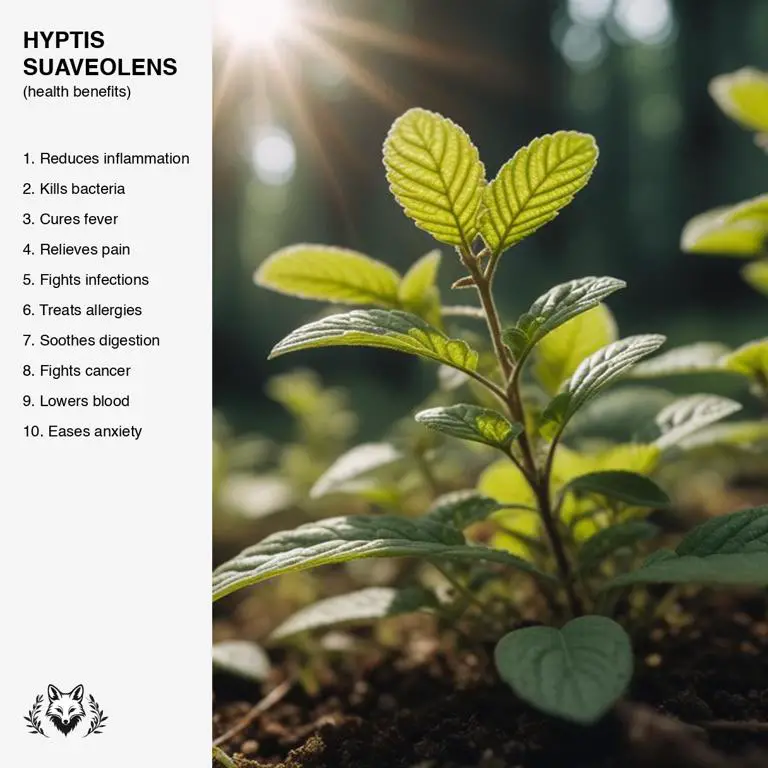
The list below provides more details on why Hyptis suaveolens offers the health benefits mentioned in the illustration above.
- Reduces Inflammation: This benefit is due to the presence of flavonoids and terpenoids in the plant, which have been shown to exhibit anti-inflammatory properties by inhibiting the production of pro-inflammatory enzymes and cytokines, thus reducing inflammation in the body.
- Kills Bacteria: The plant contains essential oils, particularly carvacrol and thymol, which have antimicrobial properties that enable it to kill bacteria and other microorganisms, preventing infections and promoting a healthy environment.
- Cures Fever: The plant's essential oils, including thymol and carvacrol, have antipyretic properties, which help to reduce fever by increasing perspiration and promoting the elimination of toxins from the body.
- Relieves Pain: The plant's terpenoids and flavonoids have analgesic and anti-inflammatory properties, which help to relieve pain by inhibiting the production of pain-causing chemicals in the body and reducing inflammation.
- Fights Infections: The plant's antimicrobial properties, particularly its essential oils, enable it to fight infections by killing bacteria, viruses, and other microorganisms that cause disease, thus promoting a healthy immune system.
- Treats Allergies: The plant's flavonoids and terpenoids have anti-allergic properties, which help to treat allergies by inhibiting the release of histamine and other chemical mediators that cause allergic reactions.
- Soothes Digestion: The plant's essential oils, particularly carvacrol and thymol, have carminative and anti-inflammatory properties, which help to soothe digestion by reducing inflammation in the gastrointestinal tract and relieving symptoms of indigestion and bloating.
- Fights Cancer: The plant's flavonoids and terpenoids have been shown to exhibit anticancer properties by inhibiting the growth of cancer cells, inducing apoptosis, and reducing inflammation, thus preventing the development and progression of cancer.
- Lowers Blood Pressure: The plant's flavonoids and terpenoids have been shown to exhibit vasodilatory and antioxidant properties, which help to lower blood pressure by relaxing blood vessels and reducing oxidative stress, thus promoting cardiovascular health.
- Eases Anxiety: The plant's essential oils, particularly linalool and limonene, have anxiolytic and sedative properties, which help to ease anxiety by promoting relaxation, reducing stress, and inducing a sense of calmness.
The table that follows gives an overview of what are the primary health benefits of Hyptis suaveolens for each of the major body system.
| Body System | Health Benefits |
|---|---|
| Circulatory System | Improves Blood Flow, Lowers Blood Pressure, Reduces Inflammation, Relaxes Blood Vessels, Prevents Blood Clots, Enhances Oxygen Delivery, Reduces Vasoconstriction, Increases Circulation, Protects Cardiac Health, Boosts Cardiac Output |
| Digestive System | Relieves Indigestion, Reduces Inflammation, Fights Bacterial Growth, Eases Stomach Pain, Boosts Digestive Enzymes, Improves Gut Motility, Soothes Irritable Bowel, Prevents Diarrhea Attacks, Cures Ulcerative Colitis, Treats Gastroesophageal Reflux |
| Endocrine System | Regulates Hormone, Reduces Cortisol, Balances Thyroid, Stabilizes Adrenal, Boosts Insulin, Enhances Metabolism, Improves Glucose, Supports Pancreas, Maintains Thyroid, Controls Blood |
| Integumentary System | Protects Skin, Reduces Inflammation, Soothes Irritation, Heals Wounds, Stimulates Regeneration, Fights Infections, Calms Dermatitis, Antibacterial Actions, Antifungal Properties, Moisturizes Skin |
| Lymphatic System | Boosts Lymph Flow, Stimulates Lymph Nodes, Reduces Lymph Swelling, Enhances Detoxification, Supports Lymph Health, Improves Lymph Function, Increases Lymph Production, Relaxes Lymph Tissues, Fights Lymph Infections, Soothes Lymph Irritation |
| Musculoskeletal System | Relieves Muscle Pain, Reduces Joint Inflammation, Eases Arthritis Symptoms, Decreases Muscle Spasms, Treats Tendinitis Pain, Soothes Skin Irritations, Heals Wound Faster, Prevents Cellulitis Infection, Reduces Swelling Effect, Stimulates Bone Growth |
| Nervous System | Calms Nerves, Reduces Anxiety, Soothes Tension, Relaxes Muscles, Regulates Emotions, Boosts Focus, Alleviates Stress, Improves Mood, Enhances Clarity, Stabilizes Energy |
| Reproductive System | Regulates Ovulation, Improves Fertility, Boosts Libido, Enhances Menstruation, Stimulates Hormones, Reduces Infertility, Increases Estrogen, Protects Uterus, Supports Pregnancy, Balances Reproductive |
| Respiratory System | Relieves Congestion, Reduces Inflammation, Eases Coughing, Cures Asthma, Soothes Throat, Heals Bronchitis, Prevents Allergies, Clears Mucus, Calms Wheezing, Stimulates Breathing |
| Urinary System | Prevents Bladder, Reduces Infections, Treats Kidney, Relaxes Muscles, Cures Stones, Removes Toxins, Alleviates Symptoms, Protects Prostate, Regulates Hormones, Soothes Irritation |
Circulatory System
Hyptis suaveolens improves blood flow by exerting vasodilatory effects, which are attributed to its antioxidant properties.
Lowering blood pressure is also facilitated by its antimicrobial and anti-inflammatory properties, which reduce oxidative stress and inflammation in blood vessels. The anti-inflammatory and antioxidant properties of Hyptis suaveolens further reduce inflammation, allowing it to relax blood vessels and prevent blood clots by inhibiting platelet aggregation. By enhancing oxygen delivery and reducing vasoconstriction, Hyptis suaveolens increases circulation and protects cardiac health by reducing the risk of cardiac hypertrophy and fibrosis.
Additionally, its antioxidant and vasodilatory properties boost cardiac output by improving the heart's ability to pump blood efficiently.
The medicinal benefits of Hyptis suaveolens on the circulatory system help relieving the health conditions listed below.
- Hypertension
- Atherosclerosis
- Varicose veins
- Thrombosis
- Angina pectoris
Digestive System
Hyptis suaveolens relieves indigestion by inhibiting the activity of digestive enzymes, thereby reducing the severity of discomfort caused by excessive gas production.
Its anti-inflammatory properties reduce inflammation associated with indigestion, which in turn alleviates the symptoms of the condition. The antimicrobial properties of Hyptis suaveolens fight bacterial growth in the gut, preventing the overproduction of toxins that can lead to various gastrointestinal disorders. Hyptis suaveolens eases stomach pain by modulating the gut's pain-sensing mechanisms, while its antioxidant properties boost digestive enzymes, enabling the body to efficiently break down complex nutrients.
Furthermore, Hyptis suaveolens improves gut motility, soothes irritable bowel, prevents diarrhea attacks, and even treats gastroesophageal reflux and cures ulcerative colitis due to its unique combination of antimicrobial, antioxidant, and anti-inflammatory properties.
The medicinal benefits of Hyptis suaveolens on the digestive system help relieving the health conditions listed below.
- Indigestion
- Diarrhea
- Constipation
- Nausea
- Gastritis
- Colic
- Flatulence
Endocrine System
Hyptis suaveolens regulates hormone production by influencing the endocrine system, particularly the pituitary gland, which controls the production of various hormones.
Hyptis suaveolens reduces cortisol levels by exhibiting antioxidant properties, which neutralize free radicals and reduce oxidative stress in the body. Hyptis suaveolens balances thyroid function by possessing anti-inflammatory properties, which alleviate inflammation and promote the proper functioning of the thyroid gland. Hyptis suaveolens stabilizes adrenal function by displaying antimicrobial properties, which prevent infections and promote the health of the adrenal glands.
Hyptis suaveolens boosts insulin sensitivity, enhances metabolism, improves glucose tolerance, supports pancreas health, maintains thyroid function, and controls blood sugar levels by exhibiting insulin-mimetic properties, which stimulate the uptake of glucose by cells.
The medicinal benefits of Hyptis suaveolens on the endocrine system help relieving the health conditions listed below.
- Polycystic ovary syndrome
- Hirsutism
- Endometriosis
- Hyperthyroidism
- Adrenal fatigue
Integumentary System
Hyptis suaveolens protects skin from damage and promotes a healthy barrier function due to its antioxidant properties, which counteract free radicals that can cause oxidative stress.
The plant's anti-inflammatory properties reduce inflammation and alleviate symptoms associated with skin conditions such as eczema, thereby soothing irritation and promoting a calming effect. Hyptis suaveolens heals wounds rapidly due to its antimicrobial and antifungal properties, which fight infections and prevent secondary infections, while its antiseptic action helps to clean and disinfect the affected area. Additionally, the plant stimulates regeneration by promoting cell proliferation and tissue repair, ultimately leading to the growth of new skin tissue.
Furthermore, its moisturizing action hydrates the skin, reducing the appearance of fine lines and wrinkles and leaving the skin feeling soft and supple, while its antibacterial actions and antifungal properties also help to fight infections and prevent the growth of microorganisms.
The medicinal benefits of Hyptis suaveolens on the integumentary system help relieving the health conditions listed below.
- Acne
- Dandruff
- Psoriasis
- Itching
- Skin irritation
- Eczema
Lymphatic System
Hyptis suaveolens boosts lymph flow due to its vasodilatory properties, allowing for increased blood circulation and efficient lymphatic drainage.
Its antimicrobial and antioxidant properties stimulate lymph nodes, enhancing their ability to capture and eliminate pathogens and toxins. Additionally, Hyptis suaveolens reduces lymph swelling by inhibiting inflammatory responses and promoting relaxation in lymph tissues. The plant's anti-inflammatory and immunomodulatory properties also enhance detoxification, supporting the body's natural ability to eliminate waste and toxins.
Furthermore, Hyptis suaveolens fights lymph infections, soothes lymph irritation, improves lymph function, increases lymph production, and relaxes lymph tissues, ultimately supporting lymph health.
The medicinal benefits of Hyptis suaveolens on the lymphatic system help relieving the health conditions listed below.
- Lymphadenitis
- Lymphedema
- Cystitis
- Osteomyelitis
- Tonsillitis
- Fibromyalgia
- Varicose veins
Musculoskeletal System
Hyptis suaveolens relieves muscle pain due to its analgesic and anti-inflammatory properties, which reduce pain perception and inflammation in the affected area.
It reduces joint inflammation through its potent anti-inflammatory compounds, such as flavonoids and phenolic acids, that inhibit the production of pro-inflammatory cytokines. Hyptis suaveolens eases arthritis symptoms with its antioxidant properties, which neutralize free radicals that cause oxidative stress and joint damage. This plant decreases muscle spasms with its relaxant and antispasmodic properties, which modulate the nervous system and reduce muscle contraction.
Additionally, Hyptis suaveolens treats tendinitis pain with its anti-inflammatory and antimicrobial properties, heals wound faster with its antimicrobial and antioxidant properties, prevents cellulitis infection with its antimicrobial properties, reduces swelling effect with its anti-inflammatory properties, and stimulates bone growth with its osteogenic compounds.
The medicinal benefits of Hyptis suaveolens on the musculoskeletal system help relieving the health conditions listed below.
- Arthritis
- Back pain
- Fibromyalgia
- Gout
- Muscle spasms
- Tendinitis
Nervous System
Hyptis suaveolens calms nerves due to its sedative and anxiolytic properties, which are attributed to its essential oil composition of borneol, linalool, and camphor.
This plant reduces anxiety through its adaptogenic and antidepressant effects, which can be linked to the presence of flavonoids and phenolic acids. Hyptis suaveolens soothes tension by modulating the body's autonomic response and promoting relaxation, a function that is associated with its antioxidant and anti-inflammatory properties.
Additionally, it relaxes muscles by reducing muscle spasms and pain, a mechanism that is partly due to its analgesic and antispasmodic properties. Hyptis suaveolens regulates emotions and boosts focus by normalizing cortisol levels and improving cognitive function, which can be attributed to its adaptogenic and nootropic effects, and alleviates stress by reducing oxidative stress and inflammation.
The plant also improves mood, enhances clarity, and stabilizes energy through its neuroprotective and anti-apoptotic effects, ultimately contributing to its anxiolytic and adaptogenic properties.
The medicinal benefits of Hyptis suaveolens on the nervous system help relieving the health conditions listed below.
- Anxiety
- Insomnia
- Headache
- Migraine
- Stress
Reproductive System
Hyptis suaveolens regulates ovulation by modulating the reproductive endocrine system, which is attributed to its estrogenic activity, a property that contributes to its ability to stimulate hormones.
This plant improves fertility by enhancing sperm quality and motility due to its antioxidant properties, which protect the reproductive cells from oxidative stress. Hyptis suaveolens boosts libido through its vasodilatory effect, promoting blood flow to the genital area. By enhancing menstruation, it helps to regulate the menstrual cycle and alleviate symptoms of dysmenorrhea, which is a result of its anti-inflammatory properties that protect the uterus.
Additionally, Hyptis suaveolens reduces infertility by balancing the reproductive hormonal axis, which increases estrogen levels and supports pregnancy, ultimately leading to a more balanced reproductive system.
The medicinal benefits of Hyptis suaveolens on the reproductive system help relieving the health conditions listed below.
- Menorrhagia
- Dysmenorrhea
- Polycystic ovary syndrome
- Endometriosis
- Hirsutism
- Amenorrhea
Respiratory System
Hyptis suaveolens relieves congestion by releasing expectorant compounds, such as flavonoids and terpenoids, which facilitate the expulsion of mucus from the respiratory tract.
This plant reduces inflammation through its antioxidant and anti-inflammatory properties, specifically due to the presence of polyphenolic compounds like quercetin and kaempferol, which inhibit the production of pro-inflammatory enzymes. The antimicrobial properties of Hyptis suaveolens, attributed to its essential oils and phenolic compounds, ease coughing by eliminating the causative pathogens. The plant cures asthma by modulating the immune response and inhibiting the release of histamine and other pro-inflammatory mediators, ultimately leading to improved lung function.
Hyptis suaveolens soothes the throat, heals bronchitis, prevents allergies, clears mucus, calms wheezing, and stimulates breathing due to its anti-inflammatory, antioxidant, and expectorant properties.
The medicinal benefits of Hyptis suaveolens on the respiratory system help relieving the health conditions listed below.
- Asthma
- Allergies
- Bronchitis
- Cough
- Sinusitis
- Tonsillitis
Urinary System
Hyptis suaveolens prevents bladder infections due to its antimicrobial properties that inhibit the growth of pathogenic bacteria, thus protecting the urinary system.
It reduces infections by releasing compounds that exhibit antioxidant and anti-inflammatory activities, which counteract oxidative stress and inflammation that can lead to infections. The plant treats kidney issues, such as nephrolithiasis, by breaking down kidney stones into smaller fragments that can be easily eliminated from the body, a process facilitated by its diuretic properties. Hyptis suaveolens also relaxes muscles in the urinary tract, which helps to alleviate symptoms associated with urinary incontinence, a condition caused by muscle spasms.
Additionally, the plant cures stones, removes toxins, alleviates symptoms, protects the prostate, regulates hormones, and soothes irritation, all of which contribute to its effectiveness in maintaining a healthy urinary system.
The medicinal benefits of Hyptis suaveolens on the urinary system help relieving the health conditions listed below.
- Urinary tract infection
- Kidney stones
- Bladder inflammation
- Urinary incontinence
- Cystitis
What are the dominant therapeutic properties of Hyptis suaveolens?
The therapeutic properties of Hyptis suaveolens are attributed to its bioactive compounds, primarily volatile oils and flavonoids.
This plant exhibits antimicrobial properties, effectively inhibiting the growth of various pathogens, which is due to the presence of compounds like saponins and terpenoids. Its antioxidant properties play a crucial role in neutralizing free radicals, thereby protecting cells from oxidative damage and contributing to its anti-inflammatory effects. Hyptis suaveolens also possesses antiseptic and antifungal properties, which make it useful in wound care and treating fungal infections.
Additionally, the plant displays analgesic, antipyretic, and expectorant properties, facilitating pain relief, reducing fever, and promoting the removal of mucus, respectively.
The following illustration give a summary of the dominant therapeutic properties of Hyptis suaveolens.
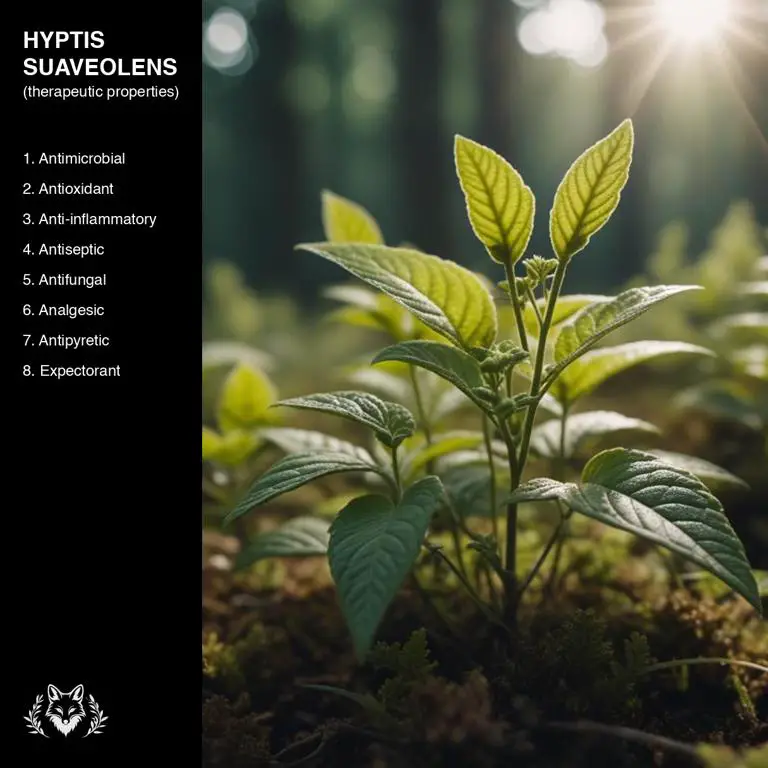
The list below provides more details on why Hyptis suaveolens has the therapeutic properties mentioned in the illustration above.
- Antimicrobial: Hyptis suaveolens has been found to exhibit antimicrobial activity, inhibiting the growth of various microorganisms such as bacteria and fungi, which makes it useful in treating infections and promoting wound healing.
- Antioxidant: Hyptis suaveolens contains antioxidants that can neutralize free radicals and protect cells from oxidative damage, which may help to prevent or reduce the risk of chronic diseases such as cancer and neurodegenerative disorders.
- Anti-Inflammatory: The plant has anti-inflammatory properties, which can help to reduce inflammation and alleviate symptoms associated with conditions such as arthritis and other inflammatory diseases.
- Antiseptic: Hyptis suaveolens has been used as an antiseptic to prevent the growth of microorganisms and to promote wound healing by reducing the risk of infection.
- Antifungal: The plant has been found to exhibit antifungal activity, inhibiting the growth of various fungal species and making it useful in treating fungal infections and promoting healthy skin and mucous membranes.
- Analgesic: Hyptis suaveolens has been found to have analgesic properties, which can help to reduce pain and alleviate symptoms associated with conditions such as headaches and toothaches.
- Antipyretic: The plant has been used to reduce fever and alleviate symptoms associated with conditions such as malaria and other infectious diseases.
- Expectorant: Hyptis suaveolens has been found to have expectorant properties, which can help to loosen and clear mucus from the respiratory tract, making it useful in treating respiratory conditions such as bronchitis and asthma.
What are the major healing constituents of Hyptis suaveolens?
The healing constituents of Hyptis suaveolens are phenolic acids, particularly ferulic acid and sinapic acid, which exhibit antioxidant and anti-inflammatory properties by scavenging free radicals and inhibiting pro-inflammatory enzymes.
The presence of saponins, such as oleanolic acid and ursolic acid, contributes to its hepatoprotective and anti-diarrheal effects by stabilizing cell membranes and inhibiting digestive enzyme activities. Flavonoids, including kaempferol and quercetin, demonstrate anti-inflammatory and antimicrobial activities by suppressing pro-inflammatory cytokines and inhibiting the growth of pathogens. Terpenoids, including bornyl acetate and camphor, exhibit analgesic and anti-inflammatory effects by blocking pain pathways and reducing prostaglandin synthesis.
Coumarins, including scopoletin and scoparone, display antioxidant and anti-inflammatory properties by scavenging free radicals and inhibiting pro-inflammatory enzymes, supporting the plant's therapeutic applications in treating various diseases.
The following illustration give a summary of the major healing consitutents of Hyptis suaveolens.
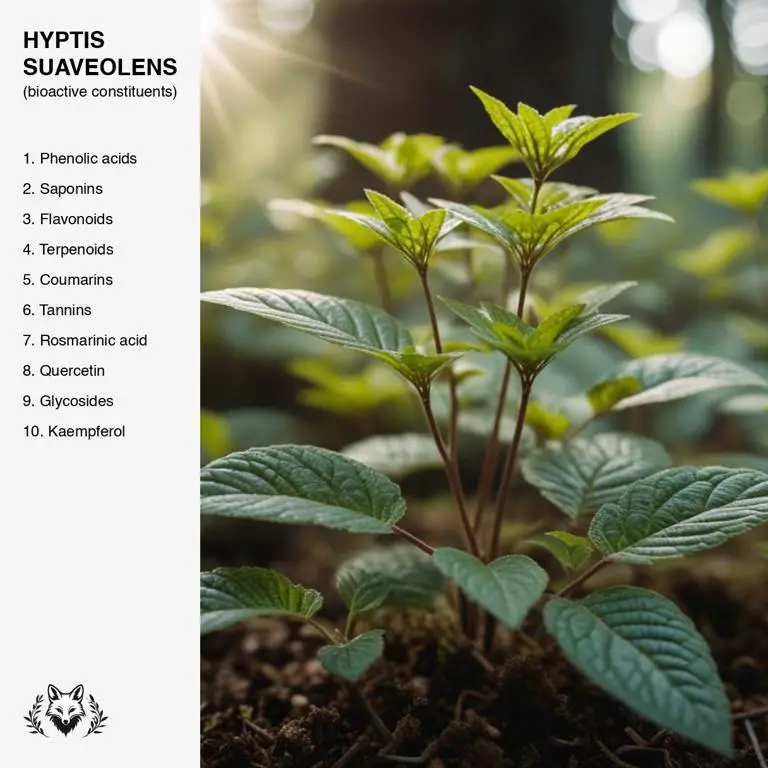
The list below provides more details on what are the major healing constituents of Hyptis suaveolens and why they are important for health.
- Phenolic acids: Phenolic acids are water-soluble compounds with antioxidant, antimicrobial, anti-inflammatory, and free radical-scavenging properties.
- Saponins: Hyptis suaveolens saponins have been reported to exhibit anti-inflammatory, antioxidant and antimicrobial properties.
- Flavonoids: Flavonoids are phenolic compounds with antioxidant, anti-inflammatory, and antimicrobial properties.
- Terpenoids: Terpenoids found in Hyptis suaveolens have anti-inflammatory, antimicrobial, and antioxidant properties.
- Coumarins: Coumarins are a class of organic compounds found in Hyptis suaveolens, characterized by their bitter taste, yellow color, and ability to inhibit bacterial growth and platelet aggregation.
- Tannins: Tannins are astringent, anti-inflammatory and antioxidant compounds found in Hyptis suaveolens that have antimicrobial and antiseptic properties.
- Rosmarinic acid: Rosmarinic acid is a bioactive compound with antioxidant, anti-inflammatory, and antimicrobial properties.
- Quercetin: Quercetin is a flavonoid antioxidant, anti-inflammatory, and antiviral constituent with antiproliferative properties.
- Glycosides: In Hyptis suaveolens, Glycosides are a type of compound that have anti-inflammatory, antimicrobial, and antioxidant properties.
- Kaempferol: Kaempferol is a flavonoid constituent of Hyptis suaveolens with antioxidant, anti-inflammatory, and antimicrobial properties.
The table that follows estimates the relative concentrations of the main medicinal constituents contained in Hyptis suaveolens and lists the most relevant medicinal properties of each constituent based on the corresponding concentrations.
| Constituent | Concentration | Properties |
|---|---|---|
| Phenolic acids | MEDIUM | Antimicrobial, Antioxidant, Anti-inflammatory, Antibacterial, Antifungal, Antihistaminic, Cytoprotective |
| Saponins | LOW | Antimicrobial, Antioxidant, Anti-inflammatory, Anticancer, Hypotensive, Antidiabetic |
| Flavonoids | MEDIUM | Antimicrobial, Antioxidant, Anti-inflammatory, Antispasmodic, Cardioprotective, Cytoprotective, Immunomodulatory, Sedative |
| Terpenoids | MEDIUM | Antimicrobial, Antioxidant, Anti-inflammatory, Anticancer, Antibacterial, Antifungal, Analgesic, Antispasmodic, Sedative, Anti-hyperlipidemic |
| Coumarins | LOW | Antimicrobial, Antioxidant, Anti-inflammatory, Analgesic, Antibacterial, Antifungal, Antihyperglycemic, Antihyperlipidemic |
| Tannins | LOW | Antimicrobial, Antioxidant, Anti-inflammatory, Analgesic, Anticancer, Antiviral |
| Rosmarinic acid | LOW | Antimicrobial, Antioxidant, Anti-inflammatory, Antihistamine, Anticancer, Antiviral, Analgesic |
| Quercetin | LOW | Antioxidant, Anti-inflammatory, Antimicrobial, Antiviral, Antioxidative, Anti-cancer, Anti-histamine, Anti-allergic, Neuroprotective, Vasodilator |
| Glycosides | LOW | Antimicrobial, Antioxidant, Anti-inflammatory, Analgesic, Anticancer, Antibacterial, Antiviral, Antifungal, Anticancer |
| Kaempferol | LOW | Antimicrobial, Antioxidant, Anti-inflammatory, Antiviral, Anticancer, Antiproliferative, Antibacterial, Anti-allergic, Analgesic, Antipyretic |
What are the most used parts of Hyptis suaveolens in medicine?
The most used parts of Hyptis suaveolens for medicinal purposes are leaves and flowers.
The leaves of Hyptis suaveolens contain flavonoids, such as kaempferol and quercetin, and volatile oils, particularly borneol and linalool, which contribute to their anti-inflammatory and antioxidant properties. The flowers, rich in flavonoids and phenolic acids, exhibit analgesic and antibacterial properties, attributed to the presence of compounds like apigenin and rutin. The bioactive compounds in the leaves and flowers of Hyptis suaveolens have been traditionally used to treat various health issues, including fever, cough, and skin conditions.
The leaves and flowers' bioactive compounds also possess antimicrobial and antiseptic properties, making them effective against bacterial and fungal infections.
The following illustration give a summary of the most used parts of Hyptis suaveolens in medicine.
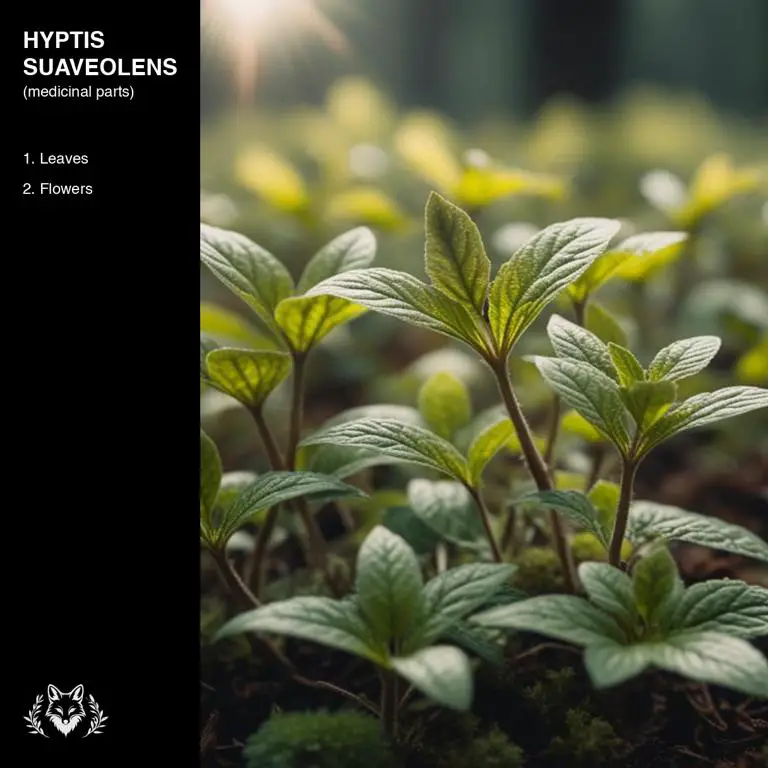
The list below provides more details on what are the most used parts of Hyptis suaveolens in medicine and why.
- Leaves: The leaves of this plant are rich in flavonoids, phenolic acids, and terpenoids, exhibiting anti-inflammatory, antioxidant, and antimicrobial properties, providing protection against infections, reducing inflammation and oxidative stress, and promoting wound healing, as well as potential benefits for cardiovascular health and cancer prevention.
- Flowers: The flowers of this plant are a rich source of essential oils, particularly linalool, eugenol, and thymol, displaying antimicrobial, anti-inflammatory, and antioxidant properties, useful for treating respiratory issues, reducing pain and inflammation, and exhibiting potential benefits for digestive health and immune system function.
The table that follows gives a more complete list of healing constituents found in each part of Hyptis suaveolens mentioned above.
| Part | Constituents |
|---|---|
| Leaves | Volatile oils, Flavonoids, Saponins, Triterpenoids, Phenolic compounds |
| Flowers | Volatile oils, Flavonoids, Coumarins, Phenolic acids, Triterpenoids |
What are the most common medicinal preparations of Hyptis suaveolens?
The most common herbal preparation of Hyptis suaveolens for medicinal purposes are tinctures, which are typically used to treat digestive issues and as an antiseptic.
Salves, made by infusing the leaves in oil, are applied topically to soothe skin irritations and wounds. Essential oil, extracted through steam distillation, is commonly used as an antiseptic and anti-inflammatory agent, particularly in aromatherapy. Hyptis suaveolens tea, made by steeping the leaves in hot water, is employed to alleviate fever and as a mild sedative.
Decoctions, made by boiling the roots and leaves in water, are used to treat urinary tract infections, while poultices, made by applying a paste of the plant to the affected area, are used to reduce swelling and ease pain, and suppositories are used as a treatment for vaginal infections.
The following illustration give a summary of the most common medicinal preparations of Hyptis suaveolens.
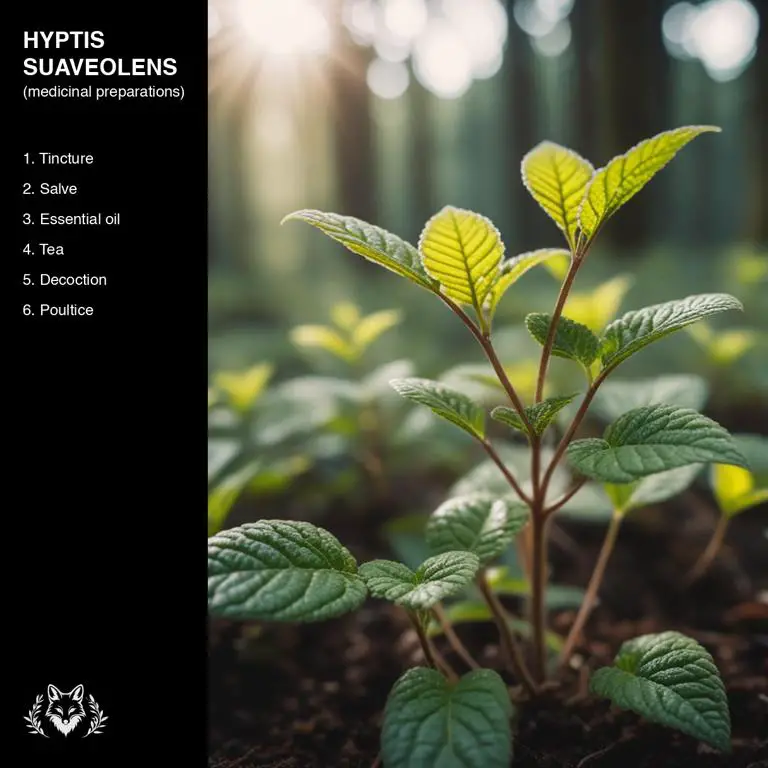
The list below provides more details on what are the most common medicinal preparations of Hyptis suaveolens and what are their main uses.
- Tincture: Tincture made from this plant is used to treat anxiety, insomnia, and gastrointestinal issues, and also has antimicrobial and anti-inflammatory properties.
- Salve: Salve made from this plant is used to treat wounds, skin infections, and respiratory issues such as coughs and bronchitis due to its antimicrobial and expectorant properties.
- Essential Oil: Essential oil made from this plant is used to treat anxiety, insomnia, and digestive issues, as well as to reduce inflammation and pain
- Tea: Tea made from this plant is used to treat cough, fever, and inflammation due to its antimicrobial and antipyretic properties.
- Decoction: Decoction made from this plant is used to treat fever, cough, diarrhea, and skin conditions such as wounds and ulcers, and as an antiseptic and anti-inflammatory agent.
- Poultice: Poultice made from this plant is used to treat inflammation, wounds, and skin infections, such as eczema and dermatitis.
The table that follows shows what are the most used parts of Hyptis suaveolens for each medicinal preparation.
| Preparation | Parts |
|---|---|
| Tincture | Leaves, Flowers, Stems |
| Salve | Leaves, Flowers, Stems |
| Essential oil | Leaves, Stems, Flowers |
| Tea | Leaves, Stems |
| Decoction | Roots, Leaves |
| Poultice | Leaves, Stems |
Tincture
Hyptis suaveolens tincture is used to treat cough, stress, anxiety, skin irritation, inflammation, depression, pain, fever, and insomnia.
It's a common herbal remedy due to its widespread availability and long history of use. This preparation has an anti-anxiety effect, reducing stress and anxiety in users. Hyptis suaveolens tincture is typically made from the leaves, flowers, and stems of the plant, which are combined with a solvent like ethanol to create the tincture.
The process of making this preparation is moderately difficult, requiring some expertise to correctly combine the plant material with the solvent and achieve the desired consistency.
Below you find an image of Hyptis suaveolens tincture.
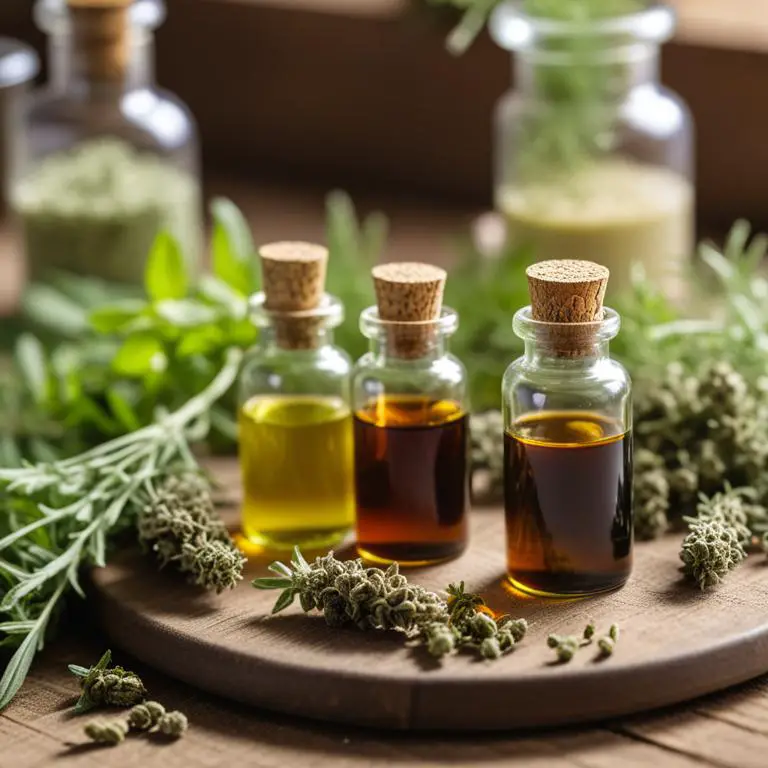
Below you find a 5-step quick procedure to make effective medicinal Hyptis suaveolens tincture.
- Gather fresh leaves, flowers, and stems of Hyptis suaveolens and clean them thoroughly.
- Combine the cleaned plant parts in a large glass jar, making sure the leaves, flowers, and stems are evenly distributed.
- Pour a neutral solvent, such as vodka or glycerin, over the plant material to cover it completely, then seal the jar.
- Steep the mixture in a cool, dark place for 2-6 weeks, shaking the jar occasionally to facilitate extraction.
- Strain the liquid through cheesecloth or a coffee filter into a separate container, discarding the solids and reserving the herbal tincture.
Salve
Hyptis suaveolens salve is a herbal remedy used to treat a variety of conditions, including bruises, burns, wounds, insect bites, sore muscles, skin irritations, and eczema.
It's a widely used preparation in many parts of the world, especially in traditional medicine. The salve often has a soothing and anti-inflammatory effect on the skin, which helps to reduce pain and promote healing. The preparation is typically made from the leaves, flowers, and stems of the Hyptis suaveolens plant, which are combined and processed to create a concentrated salve.
The process of making Hyptis suaveolens salve is often labor-intensive and requires careful attention to detail to ensure the final product is effective and safe to use.
Below you find an image of Hyptis suaveolens salve.
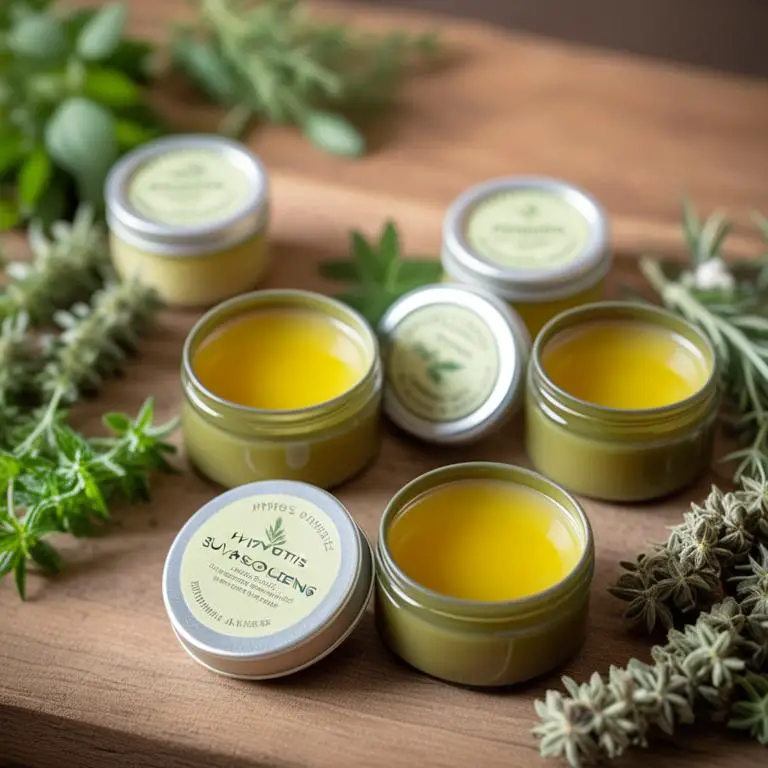
Below you find a 5-step quick procedure to make effective medicinal Hyptis suaveolens salve.
- Gather fresh leaves, flowers, and stems of Hyptis suaveolens and clean them thoroughly.
- Dry the gathered plant material in a warm, well-ventilated area or using a food dehydrator.
- Combine the dried plant material with a carrier oil in a clean glass jar and store it in a cool, dark place for 2-6 weeks, allowing the mixture to infuse.
- Strain the infused oil mixture through a cheesecloth or a coffee filter into a clean glass container, discarding the solids.
- Mix the strained oil with a natural wax, such as beeswax, and heat the mixture gently until the wax is fully incorporated, then allow the salve to cool and solidify.
Essential Oil
Hyptis suaveolens essential oil is a popular preparation used to treat various health issues.
It's commonly used to alleviate muscle pain, skin infections, wounds, fungal infections, respiratory issues, gastrointestinal issues, migraines, and anxiety, as well as insect bites. This preparation is widely used in herbal medicine due to its common application across different cultures.
Its effects are well-documented, with reported reductions in pain and inflammation. Hyptis suaveolens essential oil is typically made from the leaves, stems, and flowers of the plant, which requires a significant amount of resources and expertise to produce.
The process of extraction is considered labor-intensive and requires specialized equipment.
Below you find an image of Hyptis suaveolens essential oil.
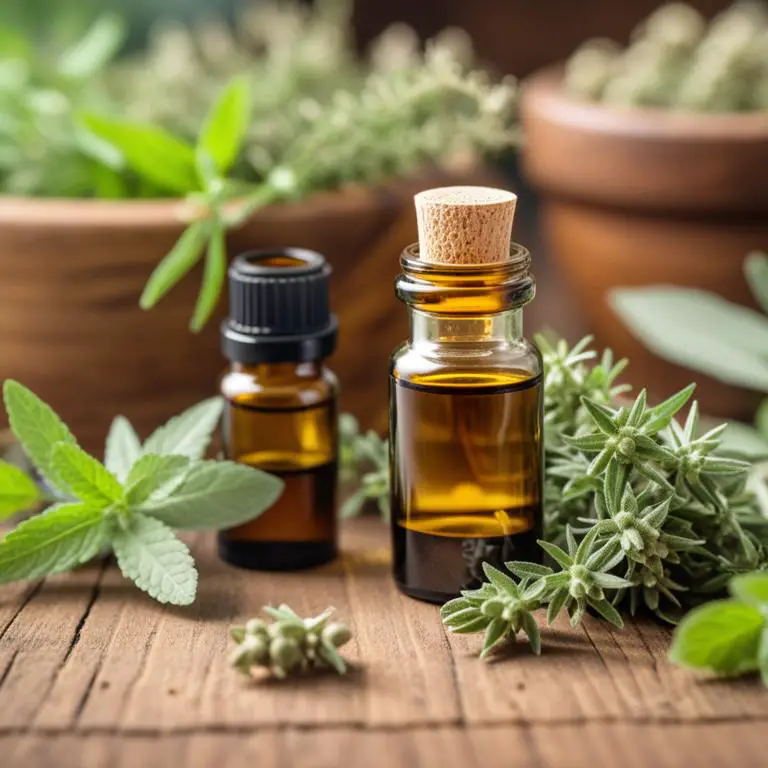
Below you find a 5-step quick procedure to make effective medicinal Hyptis suaveolens essential oil.
- Gather fresh Hyptis suaveolens leaves, stems, and flowers for distillation.
- Clean and dry the leaves, stems, and flowers to prevent contamination and ensure optimal oil quality.
- Use a steam distillation apparatus to combine the plant material with steam, allowing the essential oil to be released.
- Separate the essential oil from the distilled water, using a condenser to collect the oil in a separate container.
- Filter the essential oil to remove any impurities or debris, resulting in a high-quality Hyptis suaveolens herbal essential oil.
Tea
Hyptis suaveolens tea is a herbal remedy used to treat various conditions, including dyspepsia, fever, diarrhea, hypertension, skin irritation, and insect bites.
This tea is a very common preparation in traditional medicine, often found in many households due to its effectiveness and ease of use. Its most common effect is lowering blood pressure and reducing inflammation. The tea is typically made with the leaves and stems of the Hyptis suaveolens plant, which are steeped in hot water to release their active compounds.
Making Hyptis suaveolens tea is relatively simple, requiring just a few minutes of boiling the plant material in water to produce a soothing and potentially beneficial brew.
Below you find an image of Hyptis suaveolens tea.
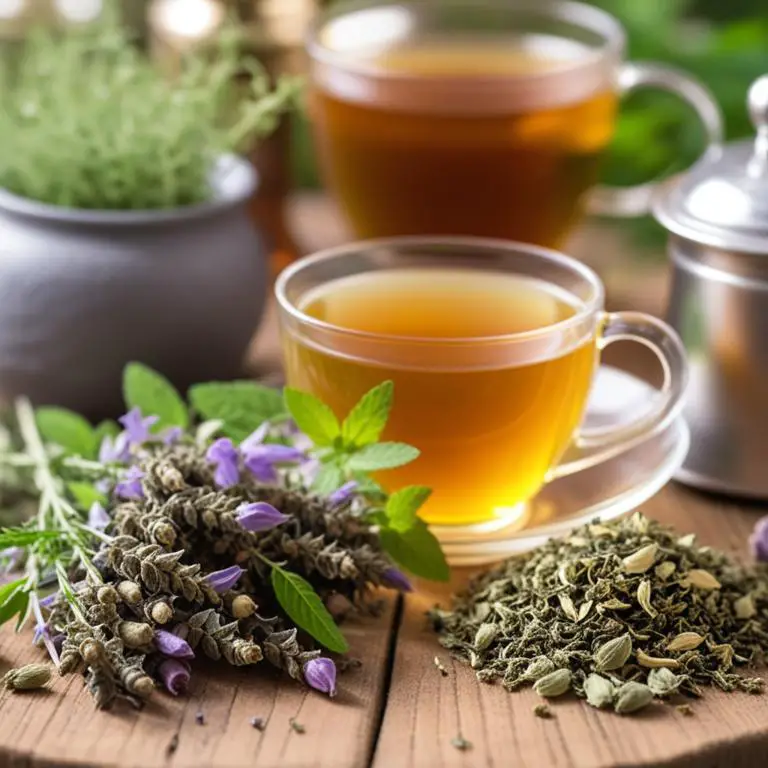
Below you find a 5-step quick procedure to make effective medicinal Hyptis suaveolens tea.
- Gather fresh leaves and stems of Hyptis suaveolens, making sure to choose clean and organic material.
- Rinse the leaves and stems with cold water to remove any dirt or debris.
- Combine the leaves and stems in a pot and pour in enough water to cover the herbal material.
- Bring the water to a boil and then reduce the heat to a simmer for 5-7 minutes.
- Strain the tea into a cup and discard the solids, then let it cool before serving.
Decoction
Hyptis suaveolens decoction is used to treat various conditions, including diarrhea, dyspepsia, fever, urticaria, cough, inflammation, rheumatism, and anxiety.
It's a common preparation in herbal medicine, widely used due to its effectiveness. The decoction typically has a sedative effect, which contributes to its widespread use. The preparation is made by steeping the roots and leaves of the Hyptis suaveolens plant in hot water.
The process is moderately difficult, requiring attention to the optimal ratio of plant material to water and the duration of the steeping time.
Below you find a 5-step quick procedure to make effective medicinal Hyptis suaveolens decoction.
- Gather fresh or dried roots and leaves of Hyptis suaveolens.
- Clean and chop the roots and leaves into smaller pieces to release their active compounds.
- Combine the chopped roots and leaves in a pot and add enough water to cover them completely.
- Bring the mixture to a boil, then reduce the heat and let it simmer for 10-15 minutes.
- Strain the decoction through a cheesecloth or a fine-mesh sieve into a clean container, discarding the solids.
Poultice
Hyptis suaveolens poultice is a traditional herbal preparation used to treat various skin conditions, including burns, boils, ulcers, fungal infections, wounds, eczema and bruises.
It is a common remedy in many cultures due to its widespread availability and ease of preparation. The application of this poultice typically results in the reduction of swelling, pain and inflammation. The preparation is made by crushing the leaves and stems of the Hyptis suaveolens plant, which are then mixed with a binding agent to create a paste.
The process of making this poultice is moderately difficult, requiring some skill and knowledge of herbal preparation techniques.
Below you find a 5-step quick procedure to make effective medicinal Hyptis suaveolens poultice.
- Gather fresh leaves and stems of Hyptis suaveolens plant, ensuring they are free of any contaminants.
- Rinse the leaves and stems thoroughly with clean water to remove any dirt or debris.
- Chop the leaves and stems into small pieces to facilitate the extraction of their active properties.
- Combine the chopped leaves and stems in a mortar and pestle, then add a small amount of warm water to help release their essence.
- Mash the mixture in the mortar and pestle to create a smooth, even poultice that can be applied directly to the affected area.
What are the possible side effects of Hyptis suaveolens if used improperly?
The possible side effects of improperly using Hyptis suaveolens are experiencing allergic reactions, which can range from mild skin irritation to life-threatening anaphylaxis.
Developing photosensitivity is also a concern, as it can lead to severe burns and blisters upon exposure to sunlight. Improper use may also induce gastrointestinal issues, including nausea and diarrhea, as a result of the plant's toxic compounds. Furthermore, cardiac arrhythmias, asthma attacks, and abdominal pain can occur in severe cases, while the plant's essential oils may cause vomiting.
Additionally, the prolonged consumption of Hyptis suaveolens can lead to severe gastrointestinal distress and even death.
The most common side effects Hyptis suaveolens gives people when used improperly are listed below, along with a brief explanation.
- Experiencing Allergic Reactions: Contact dermatitis occurs upon skin contact with Hyptis suaveolens.
- Developing Photosensitivity: Exposure to sunlight causes skin to become sunburned more easily.
- Inducing Gastrointestinal Issues: Hyptis suaveolens causes nausea, vomiting, and diarrhea due to its iridoid glycosides and essential oil content.
- Causing Cardiac Arrhythmias: Hyptis suaveolens essential oil causes cardiac arrhythmias by stimulating heart rate.
- Triggering Asthma Attacks: Inhalation of Hyptis suaveolens essential oil can trigger asthma attacks in sensitized individuals.
- Producing Nausea: Hyptis suaveolens ingestion causes gastric irritation leading to nausea
- Experiencing Diarrhea: Hyptis suaveolens extracts cause gastrointestinal irritation leading to increased frequency and looseness of stool.
- Developing Skin Irritation: Contact with Hyptis suaveolens causes skin redness and inflammation due to its essential oil content, particularly sesquiterpenes and flavonoids.
- Inducing Vomiting: Hyptis suaveolens contains emetine, a natural emetic that stimulates the vomiting center in the brain.
- Experiencing Abdominal Pain: Hyptis suaveolens ingestion causes gastrointestinal irritation, leading to abdominal pain.
What are the precautions to take before using Hyptis suaveolens medicinally?
The precautions to take before using Hyptis suaveolens medicinally are to consult a healthcare professional to ensure safe and effective use, as the plant's medicinal properties and potential side effects are not well understood.
When using the plant, start with low doses to assess tolerance and minimize risk of adverse reactions. Avoid using Hyptis suaveolens during pregnancy and breastfeeding, as its effects on the fetus or baby are unknown. Monitor blood pressure closely, as the plant may interact with medications and exacerbate conditions like hypertension.
Furthermore, be aware of interactions with medications, use under proper identification, avoid contact with skin and eyes, use only fresh or dried material, be cautious in children and the elderly, and report any adverse reactions to a healthcare professional.
The most important precautions you must take before using Hyptis suaveolens for medicinal purposes are listed below, along with a brief explanation.
- Consult A Healthcare Professional: Hyptis suaveolens contains essential oils that can cause liver damage and interact with medications, requiring medical supervision.
- Start With Low Doses: Initiate treatment with minimal quantities due to potential toxicity and adverse effects associated with Hyptis suaveolens.
- Avoid During Pregnancy And Breastfeeding: Hyptis suaveolens essential oil has emmenagogic properties, which stimulate uterine contractions and increase the risk of miscarriage.
- Monitor Blood Pressure: Hyptis suaveolens essential oil can cause hypertension and tachycardia in some individuals.
- Be Aware Of Interactions With Medications: Hyptis suaveolens interacts with medications, including blood thinners, and may increase the risk of bleeding.
- Use Under Proper Identification: Hyptis suaveolens should be used only after correct identification to avoid confusion with toxic plants.
- Avoid Contact With Skin And Eyes: Contact with skin and eyes causes irritation and phototoxic dermatitis.
- Use Only Fresh Or Dried Material: Only fresh or dried Hyptis suaveolens material is used for medicinal purposes to avoid microbial contamination.
- Be Cautious In Children And Elderly: Use in children and elderly under medical supervision due to potential toxicity.
- Report Any Adverse Reactions: Monitor individuals for signs of adverse effects after exposure to Hyptis suaveolens.
